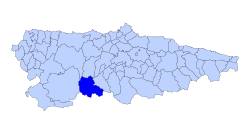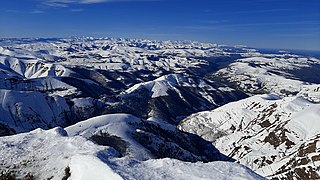
The Cantabrian Mountains or Cantabrian Range are one of the main systems of mountain ranges in Spain. They stretch for over 300 km (180 miles) across northern Spain, from the western limit of the Pyrenees to the Galician Massif in Galicia, along the coast of the Cantabrian Sea. Their easternmost end meets the Sistema Ibérico.

Cangas del Narcea is the oldest municipality in the Principality of Asturias in Spain. It is also the largest municipality in Asturias. It is in the southwest of Asturias, on the Asturian border with León. Formerly, Cangas del Narcea was known as Cangas de Tineo . Cangas del Narcea is also the name of the municipality's capital, and one of the judicial districts in Asturias.

The El Vizcaíno Biosphere Reserve, created in 1988, is located in Mulegé Municipality in northern Baja California Sur, at the center of the Baja California Peninsula between the Pacific Ocean and the Gulf of California. With an area of over 24,930 km2 (9,630 sq mi)), it is the largest wildlife refuge in Mexico and borders the northern edge of the Valle de los Cirios Protected Area of Flora and Fauna.
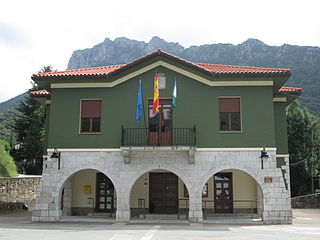
Caso is a municipality in the Spanish Principality of Asturias. It shares a boundary to the North with Piloña; to the East with Ponga; to the South with León and to the West with Sobrescobio and Laviana.

Belmonte de Miranda is a municipality in the Autonomous Community of the Principality of Asturias, Spain. It is bordered on the north by Salas, on the east by Grado, to the south by Somiedo and Teverga, and on the west by Tineo.
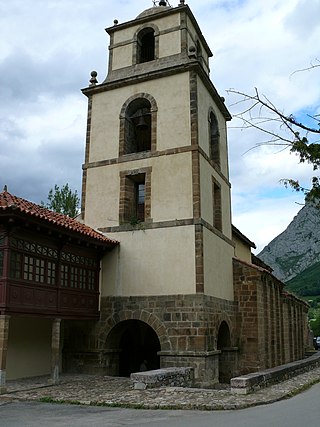
Teverga is a municipality in the Autonomous Community of the Principality of Asturias, Spain. It is bordered on the north by Belmonte de Miranda, Grado, Yernes y Tameza, and Proaza; to the south by León province, to the west by Somiedo and to the east by Quirós and Proaza.

The Picos de Europa National Park is a National Park in the Picos de Europa mountain range, in northern Spain. It is within the boundaries of three autonomous communities, Asturias, Cantabria and Castile and León, which are represented on the body which runs the park. The park is also a popular destination for hikers and trekkers.

A Pontenova is a municipality in the province of Lugo, in the autonomous community of Galicia, Spain. It belongs to the comarca of A Mariña Oriental. It has a population of 3199 and an area of 136 km².

Taramundi is a municipality in the Principality of Asturias, Spain. It neighbors on the north side with San Tirso de Abres and Vegadeo, on the east side with Villanueva de Oscos and Vegadeo, on the south side with Santa Eulalia de Oscos and A Pontenova (Lugo), and on the west side with Lugo.

Villablino is a municipality located in the Laciana comarca of the province of León in the autonomous community of Castile and León, Spain. According to the 2011 Census, the municipality had a population of 10,353 inhabitants. It has the largest commercial, economic and social center of Northwest province, and it is one of the judicial districts in the province of León.
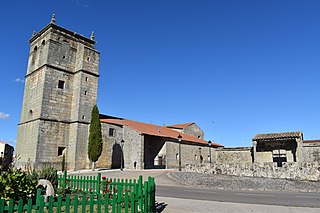
Villar del Buey is a municipality located in the province of Zamora, Castile and León, Spain. According to the 2004 census (INE), the municipality has a population of 801 inhabitants.

The Cantabrian brown bear, Iberian brown bear, or Iberian bear is a population of Eurasian brown bears living in the Cantabrian Mountains of Spain.

The Redes Natural Park is located in the Principality of Asturias in northern Spain. Its total area is 377.36 km2 (145.70 sq mi), split between two municipalities: Caso and Sobrescobio. It was declared a natural park in 1996.

Somiedo Natural Park is a protected area located in the central area of the Cantabrian Mountains in the Principality of Asturias in northern Spain. As well as being designated a natural park, it is protected as a Special Area of Conservation, and as one of a number of Biosphere Reserves in the Cantabrian mountains.(see note1)
Pola de Somiedo is one of fifteen parishes in Somiedo, a municipality within the province and autonomous community of Asturias, in northern Spain with category village ,It is situated at an elevation of 700 m (2,300 ft) above sea level. It is 19 km2 (7.3 sq mi) in size, with a population of 242. The postal code is 33840. It has a total population of 242 inhabitants in 114 homes. It is the capital city of the council. It celebrates the feast of the Rosary. His temple parish is dedicated to St. Michael.

Fuentes del Narcea, Degaña e Ibias Natural Park is a natural park in the Principality of Asturias in northern Spain. It protects a natural landscape at the sources of the rivers Narcea and Ibias. It is located within the municipalities of Cangas del Narcea, Degaña and Ibias. The park was designated in 2002 and incorporated the preexisting Muniellos biosphere reserve, which was extended in 2003.

The Turia Valley is a small valley on the western border of the Cantabrian Mountains in the northwest of Spain which is close to beaches and is divided by two autonomous communities: Asturias and Galicia. It consists of an area of 90 km2, 3,910 inhabitants and is 200 m above sea level. The two main towns are A Pontenova (Galicia) and Taramundi (Asturias).
Under UNESCO’s Man and the Biosphere Programme, there are 308 biosphere reserves recognized as part of the World Network of Biosphere Reserves in Europe and North America. These are distributed across 41 countries in the region.
The Muniellos Nature Reserve is a protected area of woodland in Asturias, Spain. The area of the nature reserve is 5,488 ha. The main species of tree is oak: it has been described as probably the best preserved Quercus robur forest in Spain.

Saliencia Lakes are a conjoined group of post-glacial lakes in Somiedo, Asturias, Spain. They are situated in the Somiedo Natural Park and are composed of the following: Calabazosa, Cerveriz, Almagrera Lagoon, and Lago de la Cueva. Lago del Valle, at 5,085 feet (1,550 m) above sea level, is the largest in the group and is the principality's largest lake. Fauna in the lake valley includes the presence of Eurasian brown bear, Otter, Egyptian vulture and Golden eagle. The majority of amphibians inside the park are found by these lakes, including Alpine newt, Palmate newt, Fire salamander, common toad, Common midwife toad, Common frog, and the Iberian frog. The lakes are protected space within the World Network of Biosphere Reserves of Somiedo Natural Park, declared a natural monument on 22 May 2003. Myth has it that the lakes are guarded by xanas.

